Thus, both liquid water and water vapor are important in absorbing heat from solar radiation and transporting and redistributing this heat around the planet.
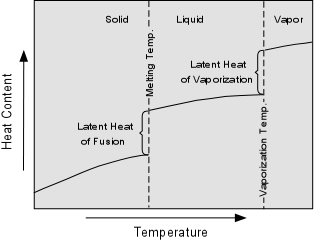
| EENS 204 | Natural Disasters |
| Tulane University | Prof. Stephen A. Nelson |
Exceptional Weather (Part I) |
|
Exceptional Weather Here we cover weather related phenomenon, including severe thunderstorms, tornadoes, tropical cyclonic storms (hurricanes, typhoons, and cyclones), nor'easters, drought, and the causes and effects of El Niņo. We have already discussed the factors involved in the circulation of the atmosphere and oceans. Knowledge of the general atmospheric circulation patterns, the Coriolis effect, and circulation around high and low atmospheric pressure areas from the previous lecture is essential for understanding the material in this section.
|
| Further energy is absorbed by water vapor as the latent heat of
vaporization, which is the heat required to evaporate water or change it from a liquid to
a vapor. This latent heat of vaporization is given up to the atmosphere when water
condenses to form liquid water as rain. If the rain changes to a solid in the form
of snow or ice, it also releases a quantity of heat known as the latent heat of
fusion. Thus, both liquid water and water vapor are important in absorbing heat from solar radiation and transporting and redistributing this heat around the planet.
|
 |
| Air Masses Due to general atmospheric circulation patterns, air masses containing differing amounts of heat and moisture move into and across North America. Polar air masses, containing little moisture and low temperatures move downward from the poles. Air masses that form over water are generally moist, and those that form over the tropical oceans are both moist and warm. Because of the Coriolis effect due to the Earth's rotation, air masses generally move across North America from west to east. But, because of the differences in moisture and heat, the collision of these air masses can cause instability in the atmosphere. |
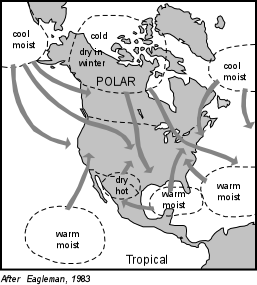 |
| Fronts and Mid-latitude Cyclones |
| When cold air moving down from the poles encounters warm moist air moving up from the Gulf of Mexico, Pacific Ocean, or Atlantic Ocean, a cold front develops and the warm moist air rises above the cold front. This rising moist air cools as it rises causing the condensation of water vapor to form rain or snow. Note that the cold air masses tend to circulate around a low pressure center in a counterclockwise fashion in the northern hemisphere. Such circulation around a low pressure center is called a mid-latitude cyclone. |
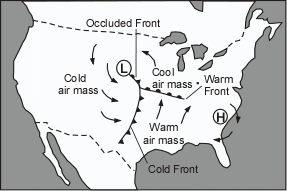 |
| When warm air moving northward meets the cooler air to the north, a warm front forms. As the warm air rises along a gently inclined warm front, clouds tend to form, and can also cause rain, but rain is less likely because the warm front is not as steep as a cold front. If the rapidly moving cold front overtakes the warm front, an occluded front forms, trapping warm air above a layer of cold and cool air. Mid-latitude cyclones and their associated fronts are responsible for such severe weather conditions as thunderstorms, snow storms and associated hail, lightening, and occasional tornadoes. | 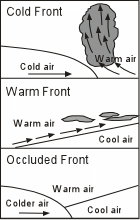 |
Thunderstorms |
|
| Thunderstorms can form as single cells, with only one cloud mass, or as
multiple cells, with several clouds moving along a similar path. Although thunderstorms can occur nearly everywhere, they show an unequal distribution through the United States. Areas that receive the highest number of thunderstorms are areas where warm moist air moves northward from the Gulf of Mexico. As seen in the figure to the right, areas in southwestern Florida have over 100 days per year with a thunderstorm |
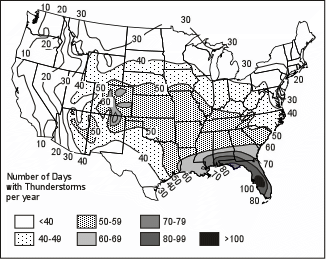 |
|
|
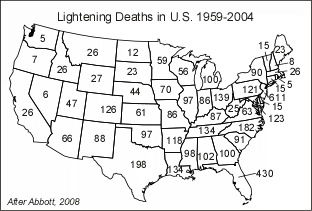 |
|
|
|
||||||||||||||||
Lightening is caused by an imbalance of electrical charge between and within clouds and the ground. Most of you have simulated lightening by walking across a carpet on a dry day and then touching a metal object like a door knob. Static electrical charge builds on your body and is discharged to the door knob as a bolt of electricity. During the buildup of a thundercloud, charged particles of water droplets and ice become separated in the cloud. Positively charged particles are moved to the top of the cloud and negatively charged particles are moved to the bottom of the cloud. |
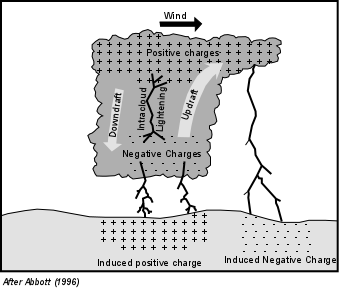 |
The thundercloud then begins to interact with the ground. The negatively charged part of the cloud induces a build-up of positive charges on the ground. Similarly beneath the upper positively charged part of the cloud negative charges are induced in the ground below. When the difference in voltage between the oppositely charged parts of the cloud and the ground become great enough, the electricity is discharged as a bolt of lightening. Note that lightening can travel from the cloud to the ground, from the ground to
the cloud, and within the cloud itself. Lightening travels at speeds of about
100,000 miles per hour, and usually includes several strokes that all occur within about
1/2 of a second. The discharge of electricity during a bolt of lightening heats up
the air surrounding the bolt causing rapid expansion of the air. It is this rapid
expansion of the air that causes the sound we call thunder. |
| Tornadoes | |
| Tornadoes are funnel shaped clouds that are associated with thunderstorms. Tornadoes have wind velocities higher than hurricanes (up to 500 km/hr [318 miles per hour]), but affect a much smaller area than hurricanes. Over 70% of the tornadoes that occur on Earth occur in the great plains of the United States. Between 1916 and 1990 tornadoes caused 11,900 deaths in the United States, an average of 159 deaths per year. |
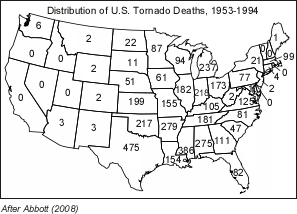 |
|
|
|
Fujita Tornado Intensity Scale F0 - F1 F2 - F3 F4 - F5 Weak Tornado Strong Tornado Violent Tornado
| F0 | 40-72 mph | Gale tornado Light damage. Some damage to chimneys; break branches off trees; push over shallow-rooted trees; damage sign boards. |
| F1 | 73-112 mph | Moderate tornado Moderate damage. The lower limit is the beginning of hurricane wind speed; peel surface off roofs; mobile homes pushed off foundations or overturned; moving autos pushed off the roads. |
| F2 | 113-157 mph | Significant tornado Considerable damage. Roofs torn off frame houses; mobile homes demolished; boxcars pushed over; large trees snapped or uprooted; light-object missiles generated. |
| F3 | 158-206 mph | Severe tornado. Severe damage. Roofs and some walls torn off well-constructed houses; trains overturned; most trees in forest uprooted; heavy cars lifted off the ground and thrown. |
| F4 | 207-260 mph | Devastating tornado Devastating damage. Well-constructed houses leveled; structures with weak foundations blown off some distance; cars thrown and large missiles generated. |
| F5 | 261-318 mph | Incredible tornado. Incredible damage. Strong frame houses lifted off foundations and carried considerable distance to disintegrate; automobile sized missiles fly through the air in excess of 100 meters(109 yds); trees debarked; incredible phenomena will occur. |
| F6 - F12 |
319 mph - MACH 1 (the speed of sound) |
The maximum wind speeds of tornadoes are not expected to reach the F6 wind speeds. |
|
 |
Tornadoes are most common during the spring and summer months. They often occur as swarms associated with cold fronts that move across the U.S. from west to east. One such swarm occurred between April 3rd and 4th, 1974. In 16 hours over 147 tornadoes touched down between Mississippi and Pennsylvania, including six tornadoes of F-5 intensity. This swarm killed 307 people, injured over 6,000, and caused property damage of about $600 million. Note the generally northeast trending tracks of the tornadoes, which is typical of most tornadoes in the U.S. |
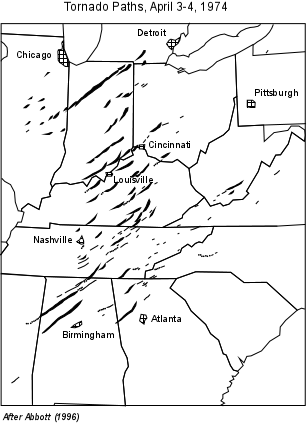 |
|
Tornado Safety (from the Federal Emergency Management Agency, FEMA)
|
| Mitigation of Tornado Disasters Because tornadoes can strike anywhere and anytime there are thunderstorms, the best mitigation is for an educated populace to be aware of the conditions under which tornadoes develop and heed any tornado watches or warnings that are issued by a responsible agency, and practice the tornado safety tips listed above. The only other mitigation that can reduce the damage produced by tornadoes is building codes that require structures to be constructed with extra reinforcing of wood frames and masonry. |